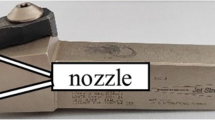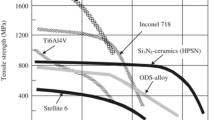Abstract
Ni-based superalloy GH4169 is widely demanded in the aerospace industry because of its excellent properties. However, the cutting of GH4169 at normal temperature has many challenges, such as tool wear, machining accuracy, and production efficiency. Cryogenic cutting has been an advanced method in assisting material removal machining. This paper focused on the cryogenic cutting performance of GH4169 at different initial temperatures, namely, 20 °C, −30 °C, −80 °C, and –130 °C. Firstly, the cryogenic mechanical properties of GH4169 were obtained by the Hopkinson pressure bar test at speed of 12 m/s and 18 m/s. The obtained data was used to analyze the cryogenic cutting performance of GH4169 at evaluated temperatures. The single factor milling experiments of GH4169 were carried out at room temperature and evaluated cryogenic levels, and the cutting performance in terms of cutting chips, cutting forces, and tool wear was investigated. The results showed that cryogenic cooling at −130 °C could increase the shear yield strength of the GH4169 by around 19.80% and the length of the cutting chip decreased monotonically by 53.45% compared with the length at room temperature. However, the cutting forces were not monotonically decreased. The cutting forces increased with the decrease of temperature when the initial temperature varied from 20 to −80 °C. However, when the initial temperature further dropped to –130 °C, the cutting forces were reduced by 30.60% for Fx, 24.02% for Fy, and 16.15% for Fz, respectively. Similarly, tool wear at the rake face and flank face is the most severe at –80 °C and the least at –130 °C. The average wear bandwidth at room temperature is 92.06 μm and decreases to 83.358 μm at –130 °C, which is reduced by 9.45%.
















Similar content being viewed by others
References
Geng Y, Mo Y, Zheng H, Li G, Wang K (2021) Effect of laser shock peening on the hot corrosion behavior of Ni-based single-crystal superalloy at 750 °C. Corros Sci 185:109419. https://doi.org/10.1016/j.corsci.2021.109419
Ren XD, Zhan QB, Yuan SQ, Zhou JZ, Wang Y, Ren NF, Sun GF et al (2014) A finite element analysis of thermal relaxation of residual stress in laser shock processing Ni-based alloy GH4169. Mater Des 54:708–711. https://doi.org/10.1016/j.matdes.2013.08.054
Chen X, Lin YC, Wen D, Zhang J, He M (2014) Dynamic recrystallization behavior of a typical nickel-based superalloy during hot deformation. Mater Eng 57:568–577. https://doi.org/10.1016/j.matdes.2013.12.072
Ezugwu EO (2005) Key improvements in the machining of difficult-to-cut aerospace superalloys. Int J Mach Tools Manuf 45:1353–1367. https://doi.org/10.1016/j.ijmachtools.2005.02.003
Zhu D, Zhang X, Ding H (2013) Tool wear characteristics in machining of nickel-based superalloys. Int J Mach Tools Manuf 64:60–77. https://doi.org/10.1016/j.ijmachtools.2012.08.001
Katna R, Suhaib M, Agrawal N (2020) Nonedible vegetable oil-based cutting fluids for machining processes - a review. Mater Manuf Process 35:1–32. https://doi.org/10.1080/10426914.2019.1697446
Sreejith PS (2008) Machining of 6061 aluminium alloy with MQL, dry and flooded lubricant conditions. Mater Lett 62:276–278. https://doi.org/10.1016/j.matlet.2007.05.019
Siniawski M, Bowman C (2009) Metal working fluids: finding green in the manufacturing process. Ind Lubr Tribol 61:60–66
Sankaranarayanan R, Rajesh Jesudoss Hynes N, Senthil Kumar J, Krolczyk GM (2021) A comprehensive review on research developments of vegetable-oil based cutting fluids for sustainable machining challenges. J Manuf Process 67:286–313. https://doi.org/10.1016/j.jmapro.2021.05.002
D’Amato R, Wang C, Calvo R, Valášek P, Ruggiero A (2019) Characterization of vegetable oil as cutting fluid. Procedia Manuf 41:145–152
Gajrani KK, Ravi SM (2017) Past and current status of eco-friendly vegetable oil based metal cutting fluids. Mater Today proc 4:3786–3795. https://doi.org/10.1016/j.matpr.2017.02.275
Wang Y, Li C, Zhang Y, Yang M, Li B, Jia D, Hou Y et al (2016) Experimental evaluation of the lubrication properties of the wheel/workpiece interface in minimum quantity lubrication (MQL) grinding using different types of vegetable oils. J Clean Prod 127:487–499
Pradeep KG, Saravanan P, Raj DS, Hussain S, Shankar VR, Raj N (2021) Optimization of jet position and investigation of the effects of multijet MQCL during end milling of Ti-6Al-4V. J Manuf Process 64:392–408
Kaynak Y (2014) Evaluation of machining performance in cryogenic machining of Inconel 718 and comparison with dry and MQL machining. Int J Adv Manuf Technol 72:919–933. https://doi.org/10.1007/s00170-014-5683-0
Shokrani A, Dhokia V, Newman ST (2018) Energy conscious cryogenic machining of Ti-6Al-4V titanium alloy. Proc Inst Mech Eng Part B J Eng Manuf 232:1690–1706. https://doi.org/10.1177/0954405416668923
Umbrello D (2013) The effects of cutting conditions on surface integrity in machining Inconel 718 alloy. Key Eng Mater 554–557:2093–2100. https://doi.org/10.4028/www.scientific.net/KEM.554-557.2093
Shah P, Khanna N, Zadafiya K, Bhalodiya M, Maruda RW, Krolczyk GM (2020) In-house development of eco-friendly lubrication techniques (EMQL, nanoparticles+EMQL and EL) for improving machining performance of 15–5 PHSS. Tribol Int 151:106476. https://doi.org/10.1016/j.triboint.2020.106476
Szczotkarz N, Mrugalski R, Maruda RW, Królczyk GM, Legutko S, Leksycki K, Dębowski D et al (2021) Cutting tool wear in turning 316L stainless steel in the conditions of minimized lubrication. Tribol Int 156:106813. https://doi.org/10.1016/j.triboint.2020.106813
Paul S, Chattopadhyay AB (1996) Determination and control of grinding zone. Int J Mach Tools Manuf 36:491–501
Hong SY, Markus I, Jeong W (2001) New cooling approach and tool life improvement in cryogenic machining of titanium alloy Ti-6Al-4V. Int J Mach Tools Manuf 41:2245–2260. https://doi.org/10.1016/S0890-6955(01)00041-4
Kaynak Y, Lu T, Jawahir IS (2014) Cryogenic machining-induced surface integrity: a review and comparison with dry, MQL, and flood-cooled machining. Mach Sci Technol 18:149–198. https://doi.org/10.1080/10910344.2014.897836
Shokrani A, Dhokia V, Newman ST (2012) Environmentally conscious machining of difficult-to-machine materials with regard to cutting fluids. Int J Mach Tools Manuf 57:83–101. https://doi.org/10.1016/j.ijmachtools.2012.02.002
Aramcharoen A, Chuan SK (2014) An experimental investigation on cryogenic milling of Inconel 718 and its sustainability assessment. Procedia CIRP 14:529–534. https://doi.org/10.1016/j.procir.2014.03.076
Hong SY, Zhao Z (1999) Thermal aspects, material considerations and cooling strategies in cryogenic machining. Clean Prod Process 1:107–116. https://doi.org/10.1007/s100980050016
Courbon C, Pusavec F, Dumont F, Rech J, Kopac J (2013) Tribological behaviour of Ti6Al4V and Inconel718 under dry and cryogenic conditions—application to the context of machining with carbide tools. Tribol Int 66:72–82. https://doi.org/10.1016/j.triboint.2013.04.010
Khanna N, Shah P, Maruda RW, Krolczyk GM, Hegab H (2020) Experimental investigation and sustainability assessment to evaluate environmentally clean machining of 15–5 PH stainless steel. J Manuf Process 56:1027–1038. https://doi.org/10.1016/j.jmapro.2020.05.016
Pusavec F, Hamdi H, Kopac J, Jawahir IS (2011) Surface integrity in cryogenic machining of nickel based alloy—Inconel 718. J Mater Process Technol 211:773–783. https://doi.org/10.1016/j.jmatprotec.2010.12.013
Khanna N, Agrawal C, Pimenov DY, Singla AK, Machado AR, Da Silva LRR, Gupta MK et al (2021) Review on design and development of cryogenic machining setups for heat resistant alloys and composites. J Manuf Process 68:398–422. https://doi.org/10.1016/j.jmapro.2021.05.053
Gupta MK, Song Q, Liu Z, Sarikaya M, Jamil M, Mia M, Khanna N et al (2021) Experimental characterisation of the performance of hybrid cryo-lubrication assisted turning of Ti–6Al–4V alloy. Tribol Int 153:106582. https://doi.org/10.1016/j.triboint.2020.106582
Lee WS, B CFL, Chen TH, Chen HW (2011) Dynamic mechanical behaviour and dislocation substructure evolution of Inconel 718 over wide temperature range. Lausanne, Switzerland, etc.: Elsevier Sequoia 6279–6286
Goulmy JP, Kanoute P, Rouhaud E, Toualbi L, Kruch S, Boyer V, Badreddine J et al (2021) A calibration procedure for the assessment of work hardening Part II: application to shot peened IN718 parts. Mater Charact 175:111068. https://doi.org/10.1016/j.matchar.2021.111068
Yamashita T, Koga N, Kawasaki T, Morooka S, Tomono S, Umezawa O, Harjo S (2021) Work hardening behavior of dual phase copper–iron alloy at low temperature. Mater Sci Eng A 819:141509. https://doi.org/10.1016/j.msea.2021.141509
Dadé M, Malaplate J, Garnier J, Barcelo F, Mompiou F, Wident P, Deschamps A (2018) Influence of temperature and strain rate on the deformation and damage mechanisms of oxide dispersion strengthened ferritic steels. Materialia 4:585–594. https://doi.org/10.1016/j.mtla.2018.11.016
Zhu S, Liu J, Deng X (2021) Modification of strain rate strengthening coefficient for Johnson-Cook constitutive model of Ti6Al4V alloy. Mater Today Commun 26:102016. https://doi.org/10.1016/j.mtcomm.2021.102016
Zhang S, Wang Z, Yang HJ, Qiao JW, Wang ZH, Wu YC (2020) Ultra-high strain-rate strengthening in ductile refractory high entropy alloys upon dynamic loading. Intermetallics 121:106699. https://doi.org/10.1016/j.intermet.2020.106699
Zhang D, Zhang X, Nie G, Yang Z, Ding H (2021) Characterization of material strain and thermal softening effects in the cutting process. Int J Mach Tools Manuf 160:103672. https://doi.org/10.1016/j.ijmachtools.2020.103672
Mirone G, Barbagallo R (2019) Coupling of temperature and strain in thermal softening of a stainless steel at low and high strain rates. Procedia Struct Integr 24:259–266. https://doi.org/10.1016/j.prostr.2020.02.023
Chao YJ, Ward JD, Sands RG (2007) Charpy impact energy, fracture toughness and ductile–brittle transition temperature of dual-phase 590 Steel. Mater Des 28:551–557. https://doi.org/10.1016/j.matdes.2005.08.009
Gill SS, Singh J, Singh H, Singh R (2012) Metallurgical and mechanical characteristics of cryogenically treated tungsten carbide (WC–Co). Inte J Adv Manuf Technol 58:119–131. https://doi.org/10.1007/s00170-011-3369-4
Varghese V, Ramesh MR, Chakradhar D (2019) Influence of deep cryogenic treatment on performance of cemented carbide (WC-Co) inserts during dry end milling of maraging steel. J Manuf Process 37:242–250. https://doi.org/10.1016/j.jmapro.2018.11.030
El-Bestawi MA, El-Wardany TI, Yan D, Tan M (1993) Performance of whiskerreinforced ceramic tools in milling nickel-based alloy. Ann CIRP 42(1):99–102
Devillez A, Schneider F, Dominiak S, Dudzinski D, Larrouquere D (2007) Cutting forces and wear in dry machining of Inconel 718 with coated carbide tools. Wear 262:931–942. https://doi.org/10.1016/j.wear.2006.10.009
Funding
This work was supported by the “National Key Research and Development Program of China (2020YFB2010600), National Science and Technology Major Project of China (Y2019-VII-0018–0160), and National Natural Science Foundation of China (52075040, 52175376).”
Author information
Authors and Affiliations
Corresponding author
Ethics declarations
Ethical approval
Not applicable.
Consent to participate
Not applicable.
Consent to publish
Not applicable.
Competing interests
The authors declare no competing interests.
Additional information
Publisher's Note
Springer Nature remains neutral with regard to jurisdictional claims in published maps and institutional affiliations.
Rights and permissions
About this article
Cite this article
Wang, Y., Pang, S., Yan, P. et al. Experimental research on cryogenic cutting performance of Ni-based superalloy GH4169. Int J Adv Manuf Technol 121, 379–392 (2022). https://doi.org/10.1007/s00170-022-09325-7
Received:
Accepted:
Published:
Issue Date:
DOI: https://doi.org/10.1007/s00170-022-09325-7




